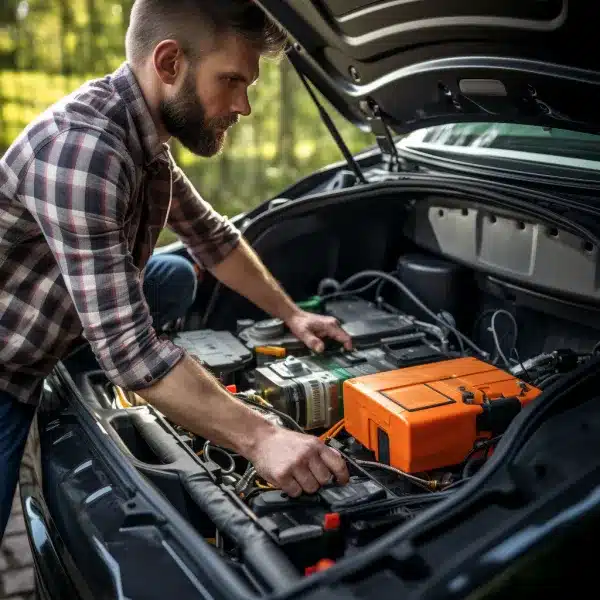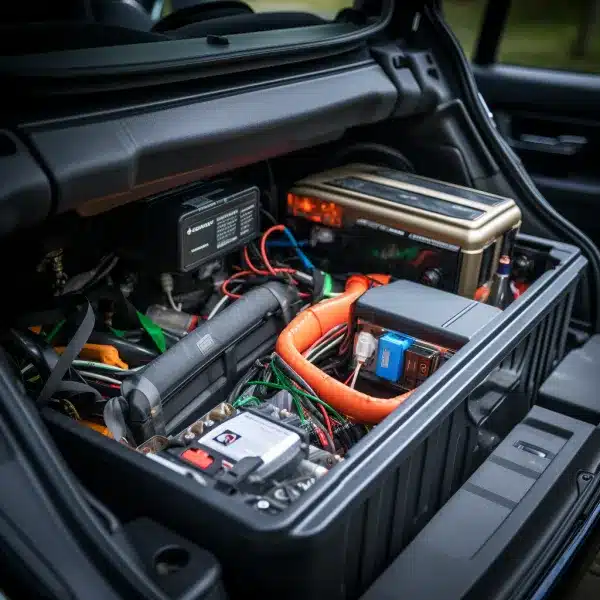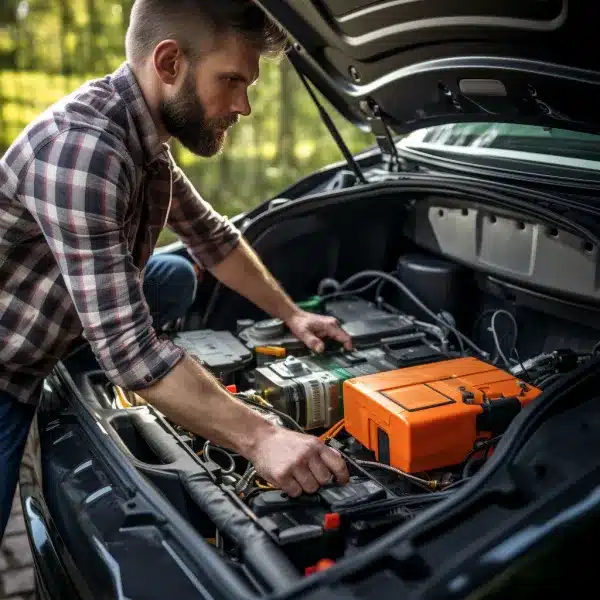
Maximizing Car Battery Life: A Comprehensive Cleaning Guide
Car Battery Cleaning Guide: Cleaning your car battery regularly is essential to ensure optimal performance and longevity. By following the correct steps and using the right equipment, you can maintain your battery’s lifespan and prevent issues down the road. In this section, I will provide you with valuable tips and detailed instructions on how to effectively clean your car battery.
Key Takeaways:
- Regularly cleaning your car battery is crucial for optimal performance and longevity.
- Using the right equipment, such as protective gloves and a toothbrush, will ensure a safe and effective cleaning process.
- Mixing baking soda with water creates a powerful solution to remove corrosion from battery terminals.
- Rinsing off the baking soda residue and drying the terminals thoroughly prevents further damage.
- Applying petroleum jelly or battery grease to the terminals helps prevent corrosion and ensures a secure connection.
Necessary equipment for cleaning a car battery
Car Battery Cleaning Guide To clean a car battery, you will need some protective gloves, baking soda, water, an old toothbrush, a rag, and petroleum jelly. These tools will help you effectively remove corrosion and ensure proper maintenance of your car battery.
Protective gloves are essential to keep your hands safe during the cleaning process. Battery corrosion can be harmful and gloves will prevent any contact with the corrosive substances. Baking soda is a versatile and effective cleaning agent that can help remove deposits from the battery terminals. Combine one tablespoon of baking soda with one cup of water to create a cleaning mixture.
An old toothbrush is perfect for scrubbing the terminals and removing any remaining corrosion. Make sure to use an old toothbrush, as it may get damaged from the cleaning process. A rag is useful for drying the terminals after rinsing off the residue. It is important to dry the terminals thoroughly to prevent further corrosion.
Car Battery Cleaning Guide Petroleum jelly is a protective agent that helps prevent future corrosion. Apply a small amount of petroleum jelly to the terminals after cleaning and reattaching the battery cables. This will create a barrier that prevents moisture and corrosion from forming.
| Equipment | Purpose |
|---|---|
| Protective gloves | Ensure safety during cleaning |
| Baking soda | Effective cleaning agent |
| Water | To mix with baking soda for cleaning |
| Old toothbrush | Scrubbing the terminals |
| Rag | Drying the terminals |
| Petroleum jelly | Prevents future corrosion |
Car Battery Cleaning Guide With these necessary tools and equipment, you are ready to clean your car battery and ensure its proper functioning and longevity. Remember to always take safety precautions and follow proper procedures when working with car batteries.
Steps to Clean a Car Battery
Follow these steps to clean your car battery and keep it in good condition:
- First, gather the necessary equipment: protective gloves, baking soda, water, an old toothbrush, a rag, and petroleum jelly.
- Next, mix one tablespoon of baking soda with one cup of water to create a cleaning solution.
- Turn off the engine and ensure the vehicle is in a well-ventilated area.
- Using the protective gloves, disconnect the negative battery cable, followed by the positive cable, using a wrench or pliers.
- Dip the toothbrush in the baking soda mixture and scrub the battery terminals thoroughly, removing any built-up corrosion or dirt.
- Rinse off the residue with water, making sure not to expose any electrical components to excessive moisture.
- Dry the battery terminals with a clean rag to prevent any moisture from causing further corrosion.
- Apply a small amount of petroleum jelly to the terminals, ensuring a protective coating.
- Reattach the positive cable followed by the negative cable, tightening them securely.
To prevent battery corrosion and maintain its lifespan, consider the following tips:
- Perform routine battery maintenance, such as cleaning the terminals, every three to six months.
- Use protective treatments, like battery terminal protectors or sprays, to prevent corrosion.
- Ensure that your battery is properly charged by regularly checking and maintaining the correct voltage.
- Coat the terminals with petroleum jelly or battery grease to create a barrier against moisture and corrosion.
By following these steps and implementing these maintenance practices, you can extend the life of your car battery and ensure optimal performance.
| Equipment | Materials |
|---|---|
| Protective gloves | Baking soda |
| Old toothbrush | Water |
| Rag | Petroleum jelly |
Disconnecting the battery cables

Car Battery Cleaning Guide Begin by turning off the engine and then carefully disconnect the negative battery cable, followed by the positive cable. This step is crucial to ensure your safety while cleaning the car battery. Remember to wear protective gloves as a precautionary measure.
To disconnect the battery cables properly, loosen the nuts on the cable clamps using a wrench or pliers. Start with the negative cable, which is usually marked with a “-“. Once the nut is loose, gently wiggle and pull the cable off the battery terminal. Repeat the process for the positive cable, marked with a “+”. Be cautious not to let the cable clamps touch each other or any metal surface to prevent electrical shock.
Before proceeding with the battery cleaning process, place the disconnected cables away from the battery terminals to avoid accidental reconnection.
Disconnecting the battery cables
| Battery Terminal | Cable Marking | Nut Size |
|---|---|---|
| Negative (-) | Black | 10mm |
| Positive (+) | Red | 10mm |
Now that you have successfully disconnected the battery cables, you can move on to the next step – cleaning the car battery. This will help eliminate any built-up corrosion and ensure optimal performance and longevity.
Scrubbing the terminals with baking soda mixture
Car Battery Cleaning Guide Mix one tablespoon of baking soda with one cup of water, and dip an old toothbrush into the mixture. The baking soda mixture is a safe and effective solution for removing corrosion from the battery terminals. The mild abrasive properties of baking soda help break down the buildup, allowing for a thorough clean.
Using the toothbrush, gently scrub the terminals and any areas where corrosion is visible. Pay close attention to the crevices and hard-to-reach spots. The bristles of the toothbrush will help dislodge the corrosion and remove any dirt or debris that may have accumulated on the terminals.
Remember to wear protective gloves throughout the cleaning process to avoid any contact with the corrosive substances. Safety should always be a priority when working with car batteries.
Precautionary Measures:
- Make sure the engine is turned off before starting the cleaning process to minimize the risk of electrical shock.
- Disconnect the negative battery cable first, followed by the positive cable.
- Be cautious and avoid touching both battery terminals simultaneously to prevent short circuits.
By following these steps, you can effectively clean the terminals of your car battery and ensure optimal performance. Regular maintenance and cleaning are essential to prolonging the lifespan of your battery and preventing issues down the road.
| Equipment | Quantity |
|---|---|
| Baking Soda | 1 tablespoon |
| Water | 1 cup |
| Old Toothbrush | 1 |
| Gloves | 1 pair |
| Rag | 1 |
| Petroleum Jelly | As needed |
To further Car Battery Cleaning Guide prevent battery corrosion and maintain its overall health, there are a few additional steps you can take. Regularly inspect your battery for any signs of damage or leakage. Keep it clean and free from dirt and debris. Consider using protective treatments, such as battery terminal protectors or sprays, which create a barrier against corrosion-causing elements. Ensure the battery is properly charged, as undercharging or overcharging can lead to premature failure. Finally, coating the terminals with petroleum jelly or battery grease provides an additional layer of protection against corrosion.
By implementing these battery cleaning tips and adopting a regular maintenance routine, you can extend the life of your car battery and avoid potential problems on the road.
Rinsing off and drying the terminals
Use water to rinse off the residue from the terminals, and then dry them thoroughly with a clean rag. It is important to remove all traces of the baking soda mixture to ensure proper contact and prevent any potential corrosion.
To rinse off the terminals, you can use a spray bottle or a hose with a gentle stream of water. Be careful not to use excessive water pressure, as it may damage the terminals. Gently spray water on the terminals, ensuring that the water reaches all corners and crevices.
After rinsing off the residue, take a clean rag and carefully dry the terminals. Wipe away any remaining water or moisture to prevent the formation of new corrosion. Pay attention to the tight spaces around the terminals, ensuring that they are completely dry.
Table: Tips for rinsing off and drying the terminals
| Tip | Description |
|---|---|
| Use a gentle stream of water | Avoid using high water pressure to prevent damage to the terminals. |
| Dry thoroughly | Ensure that the terminals are completely dry to prevent new corrosion. |
| Pay attention to tight spaces | Check and dry the areas around the terminals where moisture may accumulate. |
Once the terminals are rinsed off and dried, they will be ready for the next step in the cleaning process – applying petroleum jelly and reattaching the cables. This final step will help protect the terminals and ensure a secure connection for optimal battery performance.
Applying petroleum jelly and reattaching the cables
After the terminals are dry, apply a small amount of petroleum jelly to them, and then reattach the battery cables in the reverse order. This step is crucial for preventing corrosion and ensuring a secure connection. Petroleum jelly acts as a protective barrier, guarding the terminals against moisture and oxidation that can lead to poor electrical conductivity.
To apply the petroleum jelly, simply take a small amount on your finger or a clean cloth and coat the terminals evenly. Make sure all exposed metal surfaces are covered, including the positive and negative terminals. This will create a barrier that helps to keep moisture and dirt away, prolonging the lifespan of your car battery.
It is important to note that when reattaching the cables, you should connect the positive cable first, followed by the negative cable. This order reduces the risk of short circuits or sparks that can occur when connecting the cables. Take care to tighten the cable clamps securely but avoid overtightening, as this can damage the terminals.
| Things you will need: |
|---|
| Protective gloves |
| Baking soda |
| Water |
| An old toothbrush |
| A rag |
| Petroleum jelly |
Remember to always follow the safety guidelines when working with car batteries. Make sure to wear protective gloves and avoid contact with your eyes or skin. If you are uncertain about any step, it is best to consult a professional mechanic.
Summary:
Applying petroleum jelly to the battery terminals and reattaching the cables is a crucial step in maintaining your car battery. It creates a protective barrier against moisture and oxidation, preventing corrosion and ensuring a secure connection. Remember to follow the correct order when reconnecting the cables, with the positive cable first, followed by the negative cable. By following these steps and performing routine maintenance, you can extend the lifespan of your car battery and avoid unexpected breakdowns.
Preventing battery corrosion and maintaining battery life
Regular maintenance and protective treatments are key to preventing battery corrosion and optimizing battery life. By following these simple tips, you can ensure that your car battery remains in good condition and avoid unexpected breakdowns.
First, it is important to regularly inspect and clean your battery terminals. Corrosion can build up over time and hinder the flow of electricity. To clean the terminals, gather the necessary equipment: protective gloves, baking soda, water, an old toothbrush, a rag, and petroleum jelly. Mix one tablespoon of baking soda with one cup of water to create a cleaning solution. Turn off the engine and disconnect the negative battery cable, followed by the positive cable. Dip the toothbrush in the baking soda mixture and scrub the terminals thoroughly. Rinse off the residue with water and dry the terminals with a rag. Applying petroleum jelly to the terminals after cleaning will help prevent future corrosion.
In addition to regular cleaning, there are other preventative measures you can take. It is important to perform routine maintenance, such as checking the battery’s water level (if applicable) and keeping the battery securely fastened. Protective treatments, such as using a battery corrosion inhibitor or spray, can also help prevent corrosion. Ensure that your battery is properly charged to prevent it from becoming overworked and wearing out prematurely. Lastly, coating the terminals with petroleum jelly or battery grease will provide a protective barrier against moisture and corrosion.
| Preventive Measures | Benefits |
|---|---|
| Regular maintenance | Ensures optimal battery performance |
| Protective treatments | Prevents corrosion and extends battery life |
| Proper battery charging | Prevents premature battery failure |
| Coating terminals with petroleum jelly or battery grease | Creates a protective barrier against moisture and corrosion |
By implementing these preventative measures and regularly cleaning and maintaining your car battery, you can maximize its lifespan and ensure reliable performance for years to come.

Conclusion
By following these battery cleaning tips and incorporating routine maintenance, you can ensure a longer lifespan for your car battery.
To clean a car battery, you will need protective gloves, baking soda, water, an old toothbrush, a rag, and petroleum jelly. First, mix one tablespoon of baking soda with one cup of water. Turn off the engine and disconnect the negative battery cable, followed by the positive cable. Dip the toothbrush in the baking soda mixture and scrub the terminals thoroughly. Rinse off the residue with water and dry the terminals with a rag. Apply petroleum jelly to the terminals and reattach the cables.
To prevent battery corrosion, it is important to perform routine maintenance, use protective treatments, make sure the battery is properly charged, and coat the terminals with petroleum jelly or battery grease. Regularly check the battery for signs of corrosion and clean it promptly if necessary. Keep the battery clean and free from debris. Additionally, avoid overcharging or undercharging the battery, as it can impact its lifespan.
Remember, a well-maintained battery not only ensures reliable vehicle performance but also reduces the risk of unexpected breakdowns and costly repairs. By following these simple steps and incorporating good battery maintenance practices, you can prolong the life of your car battery and enjoy worry-free driving.
FAQ
Q: What equipment do I need to clean a car battery?
A: To clean a car battery, you will need protective gloves, baking soda, water, an old toothbrush, a rag, and petroleum jelly.
Q: How do I disconnect the battery cables before cleaning?
A: Turn off the engine and disconnect the negative battery cable, followed by the positive cable.
Q: How do I scrub the battery terminals effectively?
A: Dip a toothbrush in a mixture of one tablespoon of baking soda and one cup of water, then scrub the terminals thoroughly.
Q: What should I do after scrubbing the terminals?
A: Rinse off the residue with water and dry the terminals with a rag.
Q: How do I prevent battery corrosion?
A: Perform routine maintenance, use protective treatments, make sure the battery is properly charged, and coat the terminals with petroleum jelly or battery grease.
